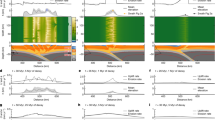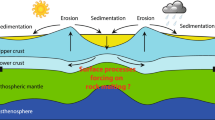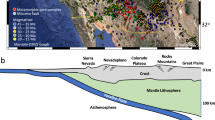Abstract
Earth’s surface topography is generated by tectonically induced variations in crustal thickness combined with erosion and, to a lesser degree, by vertical stresses caused by convection in the underlying mantle. Rock hardness and resistance to erosion are also commonly thought to influence topography because hard rocks, such as granites and basalts, usually form topographic highs in the landscape. Here we use analytical and numerical models to simulate the erosion-induced isostatic rebound of rocks. We find that the isostatic rebound that accompanies erosion causes denser rocks to occupy higher elevations in the landscape, thereby creating topographic relief that is proportional to surface rock density differences rather than rock hardness. We quantify this effect, taking into account the flexural strength of the continental lithosphere. We show that in a steady-state erosional setting, density-dependent isostatic rebound can cause the densest rocks to be exhumed at double the rate of surrounding, less-dense rocks and has a stronger effect than typical rock hardness variations. The results imply that denser rock formations should erode faster and therefore be characterized by younger thermochronological ages. Thermochronological data sets from the Kinabalu granite in Borneo and the Shakhdara–Alichur gneiss domes in Pamir confirm this counter-intuitive result. Our findings imply that lateral variations in surface rock density have significant control on the shaping of the large-scale features of Earth’s surface.
This is a preview of subscription content, access via your institution
Access options
Subscribe to this journal
Receive 12 print issues and online access
$259.00 per year
only $21.58 per issue
Buy this article
- Purchase on Springer Link
- Instant access to full article PDF
Prices may be subject to local taxes which are calculated during checkout





Similar content being viewed by others
References
Gilbert, G. Report on the geology of the Henry Mountains (US Geographical and Geological Survey of the Rocky Mountain Region, 1877)
Nyblade, A. A. & Sleep, N. H. Long lasting epeirogenic uplift from mantle plumes and the origin of the Southern African Plateau. Geochem. Geophys. Geosyst. 4, 1105–1133 (2003).
Stübner, K. et al. The giant Shakhdara migmatitic gneiss dome, Pamir, India–Asia collision zone, II: Timing of dome formation. Tectonics 32, 1–28 (2013).
Tenzer, R., Sirguey, P., Rattenbury, M. & Nicolson, J. A digital rock density map of New Zealand. Comput. Geosci. 37, 1181–1191 (2011).
Zappone, A. S. & Bruijn, R. H. The Swiss atlas of physical properties of rocks (SAPHYR). Rapport Annuel 2012, Commission Suisse de Geophysique CSGP (2012)
Sharma, P. Environmental and Engineering Geophysics (Cambridge Univ. Press, 1997).
Molnar, P. & England, P. Late Cenozoic uplift of mountain ranges and global climate change: Chicken and egg? Nature 346, 29–34 (1990).
Montgomery, D. Valley incision and the uplift of mountain peaks. J. Geophys. Res. 99, 13913–13921 (1994).
Braun, J. & Willett, S. A very efficient O(n), implicit and parallel method to solve the basic stream power law equation governing fluvial incision and landscape evolution. Geomorphology 180–181, 170–179 (2013).
Burov, E. & Diament, M. The effective elastic thickness (Te) of continental lithosphere: What does it really mean? J. Geophys. Res. 100, 3905–3928 (1995).
Burov, E. & Diament, M. Isostasy, equivalent elastic thickness, and inelastic rheology of continents and oceans. Geology 24, 419–422 (1996).
Watts, A. Isostasy and Flexure of the Lithosphere (Cambridge Univ. Press, 2001).
Mouthereau, F., Watts, A. B. & Burov, E. Structure of orogenic belts controlled by lithosphere age. Nature Geosci. 6, 1–5 (2013).
McKenzie, D. & Fairhead, D. Estimates of the effective elastic thickness of the continental lithosphere from Bouguer and free air gravity anomalies. J. Geophys. Res. 102, 27523–27552 (1997).
Braun, J. & van der Beek, P. Evolution of passive margin escarpments: What can we learn from low-temperature thermochronology? J. Geophys. Res. 109, 327–341 (2004).
Daly, E., Brown, C., Stark, C. P. & Ebinger, C. J. Wavelet and multitaper coherence methods for assessing the elastic thickness of the Irish Atlantic margin. Geophys. J. Int. 159, 445–459 (2004).
Flück, P. Effective elastic thickness Teof the lithosphere in western Canada. J. Geophys. Res. 108, 2430–2413 (2003).
Cattin, R. et al. Gravity anomalies, crustal structure and thermo-mechanical support of the Himalaya of Central Nepal. Geophys. J. Int. 147, 381–392 (2001).
Clift, P., Lin, J. & Barckhausen, U. Evidence of low flexural rigidity and low viscosity lower continental crust during continental break-up in the South China Sea. Mar. Pet. Geol. 19, 951–970 (2002).
Brown, R., Summerfield, M. & Gleadow, A. in Process Models and Theoretical Geomorphology, 23–53 (ed Kirby, M.) (John Wiley, 1994).
Fitzgerald, P. & Gleadow, A. Fission-track geochronology, tectonics and structure of the Transantarctic Mountains in Northern Victoria Land, Antarctica. Comput. Geosci. 73, 169–198 (1988).
Cottam, M. et al. Neogene rock uplift and erosion in Northern Borneo: Evidence from the Kinabalu granite, Mount Kinabalu. J. Geol. Soc. Lond. 170, 805–816 (2013).
Raab, M., Brown, R., Gallagher, K., Weber, K. & Gleadow, A. Denudational and thermal history of the early cretaceous Brandberg and Okenyenya igneous complexes on Namibia’s Atlantic passive margin. Tectonics 24, TC3006 (2005).
Rust, R. & Summerfield, M. Isopach and borehole data as indicators of rifted margin evolution in southwestern Africa. Mar. Pet. Geol. 7, 277–287 (1990).
Matmon, A., Mushkin, A., Enzel, Y., Grodek, T. & Team, A. Erosion of a granite inselberg, Gross Spitzkoppe, Namib Desert. Geomorphology 201, 1–8 (2013).
Davis, W. M. Granitic domes of the Mohave Desert, Calif. Trans. San Diego Soc. Natural Hist. 7, 211–258 (1933).
Leake, B. E. Granite magmas: Their sources, initiation and consequences of emplacement. J. Geol. Soc. Lond. 147, 579–589 (1990).
Peschler, A. P., Benn, K. & Roest, W. R. Insights on Archean continental geodynamics from gravity modelling of granite–greenstone terranes. J. Geol. 38, 185–207 (2004).
Daly, R. A., Manger, G. E. & Clark Jr, S.P. Section 4: Density of rocks. Geol. Soc. Am. 97, 19–26 (1966).
Lithgow-Bertelloni, C. & Silver, P. Dynamic topography, plate driving forces and the African superswell. Nature 395, 269–272 (1998).
Moucha, R. et al. Deep mantle forces and the uplift of the Colorado Plateau. Geophys. Res. Lett. 36, L19310 (2009).
Karlstrom, K. E. et al. Mantle-driven dynamic uplift of the Rocky Mountains and Colorado Plateau and its surface response: Toward a unified hypothesis. Lithosphere 4, 3–22 (2012).
De Wit, M. The Kalahari Epeirogeny and climate change: Differentiating cause and effect from core to space. S. Afr. J. Geol. 110, 367–392 (2007).
Partridge, T. & Maud, R. Geomorphic evolution of southern Africa since the Mesozoic. S. Afr. J. Geol. 90, 179–208 (1987).
Thomson, S. N. et al. Thermochronologic evidence for orogen-parallel variability in wedge kinematics during extending convergent orogenesis of the northern Apennines, Italy. Geol. Soc. Am. Bull. 122, 1160–1179 (2010).
Braun, J. Pecube: A new finite element code to solve the heat transport equation in three dimensions in the Earth’s crust including the effects of a time-varying, finite amplitude surface topography. Comput. Geosci. 29, 787–794 (2003).
Braun, J. et al. Quantifying rates of landscape evolution and tectonic processes by thermochronology and numerical modeling of crustal heat transport using PECUBE . Tectonophysics 524–525, 1–28 (2012).
Wolf, R., Farley, K. & Kass, D. M. Modeling of the temperature sensitivity of the apatite (U–Th)/He thermochronometer. Comput. Geosci. 148, 105–114 (1998).
Acknowledgements
The work reported in this manuscript has been supported by the Canadian Institute for Advanced Research.
Author information
Authors and Affiliations
Contributions
All authors have contributed to the main idea described in this manuscript and to its writing; J.B. has developed the mathematical formalism and performed the numerical simulations; T.S-L., K.E.M. and P.W.R. have suggested and documented the various examples used to support our hypothesis.
Corresponding author
Ethics declarations
Competing interests
The authors declare no competing financial interests.
Supplementary information
Rights and permissions
About this article
Cite this article
Braun, J., Simon-Labric, T., Murray, K. et al. Topographic relief driven by variations in surface rock density. Nature Geosci 7, 534–540 (2014). https://doi.org/10.1038/ngeo2171
Received:
Accepted:
Published:
Issue Date:
DOI: https://doi.org/10.1038/ngeo2171
This article is cited by
-
Past rainfall-driven erosion on the Chinese loess plateau inferred from archaeological evidence from Wucheng City, Shanxi
Communications Earth & Environment (2023)
-
Post-subduction tectonics induced by extension from a lithospheric drip
Nature Geoscience (2023)
-
Global dominance of tectonics over climate in shaping river longitudinal profiles
Nature Geoscience (2021)
-
Paleotopographic controls on modern gully evolution in the loess landforms of China
Science China Earth Sciences (2017)
-
Present-day uplift of the western Alps
Scientific Reports (2016)



